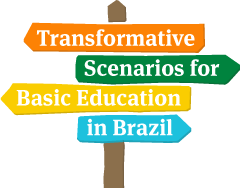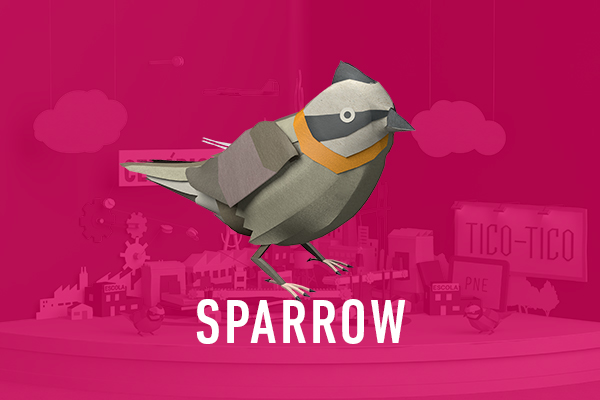Comparison of the Scenarios
The tables below enable comparison among the four scenarios based on their differentiating elements as defined by the Scenario Team:
| Canary | Hummingbird | Peregrine Falcon | Sparrow |
|---|---|---|---|
| Educational inequalities are materially reduced, but inequalities based on income, race/color, gender, regional diversity, rural/urban origins, and city center/suburbs persist. The discrimination and prejudice present in schools and in public policies is not overcome
Inclusion is pursued in a certain fashion, without overturning Eurocentric dominance |
Education as a promoter of equity, recognition of existing inequalities
Social sustainability contributes to reducing inequalities in gender, regional diversity, race/color, suburbs vs. city centers and rural areas Political conflicts arising from overcoming inequalities are not often appropriately addressed Individual diversity is valued in detriment to collective diversity |
Inequality is reduced for individuals and a few groups, however, structural inequality remains
Some break the cycle of inequality via competition or merit The competitive advantage of diversity does not change other inequalities Diversity as a business opportunity |
Reduction of educational inequality by income level, with other types of inequality remaining, in particular the difference between rural and urban environments
Precarious inclusion of a few and exclusion of others Increase in violence Debate diversity vs. inequality |
| Canary | Hummingbird | Peregrine Falcon | Sparrow |
|---|---|---|---|
| Social participation and control of public policies by the school community and society at large
Strong student participation An open and close relationship between school and the society |
Rights are guaranteed with co-responsibility and social control
Participation of stakeholders: family, educational institutions, community A push for the renewal of basic education stem from social organizations and movements, teachers, students and other stakeholders |
Freedom to choose the school: family/students as consumers/ customers
Weakened system of social participation Some resistance focuses Participation as customers |
Social movements take part in councils, but decisions have little effect
Tension between forces from the bottom up and the resistance by the State and society Sense of improvement due to access to consumption leads to fragmentation of agendas and actions of movements |
| Canary | Hummingbird | Peregrine Falcon | Sparrow |
|---|---|---|---|
| Fundamental and strategic role in guaranteeing the right to education
Provider of what is essential Culture of discontinuity in educational policies is interrupted Central focus is attaining the National Education Plan (NEP) goals |
Facilitator, guide, agent of promotion / induction
Encourages improvements beyond what is essential: innovation Non-state-controlled public policy Co-responsibility for educational policy |
Provider of minimum services
Regulator, funder and evaluator of the private sector Less execution (private delivers more) Higher corporate influence, funding is supplemented by business |
The State is the evaluator, but is unable to regulate
The State is unable to ensure what is essential The State strives to universalize the right to education, but is unable to tackle structural inequalities, reproducing unequal quality standards |
| Canary | Hummingbird | Peregrine Falcon | Sparrow |
|---|---|---|---|
| Anchored to official and formal public policies based on laws, built and negotiated with the participation of civil society
Holistic education regarding space, content and new players School has the function of democratizing access to knowledge and guaranteeing the appropriation of culture |
Deep reforms motivated by social, environmental and technological changes
Connected to contemporary times School has the social function of shaping global and everyday agents of change Teacher: articulator, mediator, curator, designer, author |
Quality = employability and performance as measured by assessments
NEP: progress in quantitative access, but not much in quality Single curriculum Standardized materials Focus on improvement of human capital (qualified and specialized labor force) Teachers as mere executors |
Massified and ineffective education with attempts to address diversity, but as a peripheral concern
Prevalence of the concept of the formal, traditional school, as defined in legislation, with basically no innovation Conservative religious influence Lay education is questioned |
| Canary | Hummingbird | Peregrine Falcon | Sparrow |
|---|---|---|---|
| Inter-sectorial management between schools and other public policy units
Accountability based on conditions to guarantee rights Strategic role of school administrators Democratic management |
Democratic management with participation of all stakeholders
Holistic management (meals, sustainable practices, sustainable educational spaces) Inter-sectorial management Space for ongoing innovation |
Results-based management
Performance-based management of students Variable remuneration (bonus, rewards) Ranking Agile decision-making |
Results-based management combined with an institutional framework that is participatory in nature with little effectiveness in influencing decision-making
Collegiate bodies drained and bureaucratized Role of the school: access for all, quality for a few |
| Canary | Hummingbird | Peregrine Falcon | Sparrow |
|---|---|---|---|
| Public policy establishes clear parameters for these relationships, considering the regulation of private players.
The relationship with the private sector players goes beyond the role of the State. Improved quality in public schools increases enrollment of middle-class students in establishments built and maintained by the State |
Plurality of public-private arrangements, with emphasis on non-profit models
Space for collective discussion on public-private partnerships Private sector players invest in technological innovation Entry of new players There is a need for strong regulation and permanent social control |
Significant increase in the transfer of public resources to private educational institutions (for profit and non- profit)
Increase in PPPs, scholarships and agreements Increased enrollment in private educational institutions (with subsidies and scholarships) Increased concentration of private sector education in the hands of a few players |
Public state policy and public-private partnerships involved in providing enrollments, determining management culture and the sale /offer of new solutions: teaching systems, services, school materials, social technologies |





